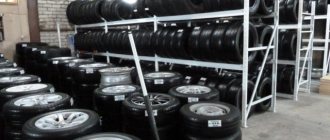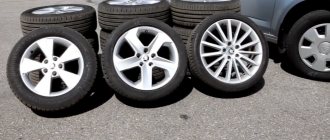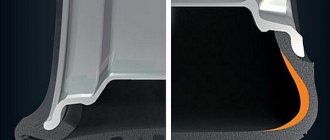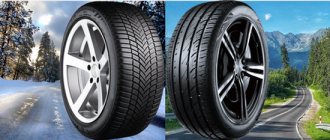Properly storing car tires forces many car owners to twice a year seasonally when it is necessary to change tires from one type to another. Every car owner knows about this, and therefore many have more than one set of tires for the season. However, few people think about the proper storage of tires, and do not attach much importance to this issue.
Despite poor literacy in this problem, proper storage of car tires is not an easy task. You can’t dump all the summer tires in a heap in one corner of the garage in the fall and install them on the car in the spring. Improper storage of tires significantly reduces their service life; their technical parameters and road safety depend on this, especially in winter with icy conditions or when cornering at high speed.
Store without or on disks
Car owners who are deciding how to properly store tires when the season changes do not always know whether they need to remove the tires from the rims during storage. There is not much difference or any rules in this matter. It depends only on the desire of the car owner and the availability of space in the garage or other room for separate storage of wheels and tires.
It can be stored in any form, but there are some special features for this.
Disk storage
If you decide to store the tires and not remove them from the rims, then it is recommended to follow some rules that will help prevent tire deformation and eventual damage. There is one rule that must be strictly followed - do not store tires on rims in a vertical position. To do this, you need to select a place where it is recommended to place a wooden pallet. The wheels need to be folded horizontally onto it.
Tires can be stored stacked on top of each other. If there is not enough space on the floor for storage, the wheels can be hung. This is an acceptable way to store tires without damaging them.
Storage without disks
When storing tires without rims, you need to be aware that they cannot be stacked on top of each other, or suspended, as they will become deformed and tire mounting may become impossible, or the tires will become unusable. Without discs, tires can only be stored in a vertical position. It is better if there is space in the room to build a storage rack that you can make yourself.
When storing vertically, be sure to periodically turn the tires once a month. Otherwise, the tires will become deformed after the end of the storage season.
Force majeure
What to do if storage standards were not met and the tire, or even the entire set, was deformed. Situations are different, and the degree of negligence varies for everyone. Simply put, all that remains is to throw away the wheels, but even here everything is not so obvious. As it turned out, it is impossible to leave rubber next to the trash can, since this element is subject to special disposal.
You can go and change your shoes to a tire shop, and at the same time buy a new set of wheels there. These guys often have an alliance with companies that are engaged in the safe disposal and processing of such rubber products. Each wheel will cost you from 100 to 200 rubles, depending on tread wear and the manufacturer. Additionally, pay 50-70 rubles per spike.
Unfortunately, not all services accept used tires for further processing . And it’s not a fact that the guys who did agree transform the raw materials properly, since things are frankly lousy with recycling in Russia, since the demand for old tires in the country is catastrophically low. Your wheels may simply be thrown into a general landfill, although this is prohibited. On the other hand, the responsibility is made a little easier by the fact that it was not you who did it, but third parties, although it doesn’t make it any easier.
General storage rules
There are several simple rules with which you can save expensive rubber from deformation during storage and use it for the entire service life calculated by the manufacturer. These rules include:
- After removing the wheels from the car, you must thoroughly wash them and conduct a visual inspection for any stones or dirt remaining in the tread.
- Check the pressure with a device. It must be equal to the factory recommendations, which is a mandatory parameter for tubeless tires.
- Wheels and tires must be marked with the location of the tire installation and the side facing the body.
These are the minimum requirements that allow the tires to last between seasons, as well as correct tire wear, since it will be possible to make the correct replacement.
Where should you not leave your tires?
It is strongly recommended not to leave tires in public areas such as hallways. staircases or attics. Firstly, this storage method is contrary to fire safety regulations. In addition, storing tires in these places is unlikely to please neighbors and will most likely lead to a conflict situation. Also, you should not leave tires directly in the apartment. It must be remembered that rubber emits toxic phenol and an unpleasant characteristic odor during storage.
What affects the safety of tires
During storage of rubber, various factors act on it, which negatively affect its condition. To properly store tires at home, it is necessary to consider the influence of each factor.
Moisture
Proper preservation of tires on rims or removed from rims is only possible in a dry place, without any exceptions. High humidity in the room where tires are stored makes them unusable, and at the beginning of the season, using such wheels can become dangerous and even impossible. Therefore, it is necessary to carefully select a place to store car tires. This could be a basement, dry garage, storage room. You can store tires on the balcony, provided that it is glazed and moisture does not penetrate into it.
A common mistake owners make when storing tires is using plastic bags. Under no circumstances should such storage be allowed, since bags create conditions for the accumulation of condensation and dampness. In addition, if the tires are on steel wheels, then the wheels in bags will quickly begin to rust. The optimal solution would be to use special non-woven bags. It is better to buy a separate bag for each wheel.
sunlight
The sun's rays are harmful to any car tires. Their surface dries out and cracks. During an external inspection, such microcracks may not be noticed, but if a wheel falls into a deep hole while driving a car, or if other objects impact this wheel, it may burst.
Temperature
Modern high-quality tires have a peculiarity in storage temperature, which should not be negative, but not more than +25 degrees. Therefore, it is not recommended to use unheated cold garages for storage, just as you should not store tires at high temperatures near heating devices. This can lead to changes in tire parameters for the worse.
Chemicals and deformation
If rubber is constantly stored in one position, it will soon become deformed. The same will happen if the rubber is stored suspended without discs, since this will cause an uneven impact on it. Car tires are not designed to withstand such loads.
Chemicals are also destructive to tires. Such automotive chemicals may include acids, solvents, gasoline and lubricants. There are plenty of them in any garage.
Shelf life
Any car tires, regardless of their quality, cost and manufacturer, have a certain shelf life. Typically, if all necessary conditions are met, this period does not exceed 6 years from the date of manufacture. This depends on the chemical composition of the rubber, which includes chemical softeners in the rubber compound. At the end of their service life, tires begin to lose their quality, and the tire becomes harder, cracks and drys out. Driving on wheels with such tires becomes dangerous.
An interesting fact is that car tires installed on a car and not removed for storage can last longer than tires in storage. This is explained by the fact that chemical rubber softeners act only when tires are running and maintain their elasticity. Therefore, when purchasing car tires as a spare, you need to take this feature into account and try to follow all the rules during storage. There are special aerosols that slightly increase the shelf life of car tires.
Is it worth storing tires?
Many car owners do not have a place to store their car tires, or it is not always possible to create the necessary conditions for proper storage of rubber. It is quite difficult to create a temperature regime, especially in winter. When storing winter tires in summer, a similar problem arises - the temperature in summer very often exceeds +25 degrees.
Recently a new service for storing wheels or tires has appeared. Such centers are created at large auto markets, car repair services and other places. You can donate winter or summer tires there for any period of time. Since the warehouses of such organizations have the necessary equipment: tire washers, climate systems, shelves, car tires will be qualitatively controlled and stored in the necessary conditions.
Such organizations have specially trained people on staff who have the skills to properly store tires or wheel assemblies with rubber. Usually there is constant monitoring of the condition of the wheels, and if it is necessary to turn over the delivered products at a certain frequency, everything will be done. Therefore, if it is not possible to independently find a place to store car tires, especially high-quality and expensive ones, then contacting such services will be the best option.
How to store wheels at home
With the arrival of the cold season, car drivers face difficulties not only with purchasing and installing wheels, but also with storing them. Proper storage conditions for a removed set of tires will help extend its performance and service life. If tires are stored incorrectly, they can become unusable within one season.
If the car owner has no other storage options, then you can think about storing tires at home.
First you need to clean the tires from dirt, stones and dust, otherwise the abrasive elements will cause great damage to the tread. Then you should dry it, otherwise moisture will cause mold. Tires can be left unpacked, or packed in textile covers for better ventilation. Next, you need to find a storage location.
Tires should not be stored in the following places:
- On the staircase, in the cold floor area, in the common apartment vestibule. At first glance, these places are suitable for storing wheels, but such rooms cannot be cluttered due to fire safety, and besides, this will cause inconvenience to other people.
- In a cold or warm garage, but next to radiators, under dripping pipes, on shelves with sharp edges. Very low or high temperatures, high humidity or dry air will only harm the tread material. In poor conditions, tires will quickly lose their performance properties. Uneven and sharp edges on which the wheels will be placed will lead to damage to the rubber or its deformation.
- On an unglazed balcony. Storing tires in such a place is the same as storing them on the street. They will be affected by the sun, moisture, frost and wind. These negative factors can lead to wheel damage in one season.
Tires may be stored in the following places:
- In a clean and dry storage room in the apartment. You just need to be sure that there is no steam from the bathroom or heated kitchen air in the pantry. The pantry is an indispensable place to store a second set of tires without rims. This room is located inside the apartment, protected from the sun's rays and temperature changes. The pantry is always dark and dry - these are ideal conditions for rubber. Chemicals should not be stored nearby.
- On a heated glass balcony.
- In a heated, dry garage. Here you need to know that there should be no chemicals or open fire with flying sparks near car tires. For many car enthusiasts this place is the most suitable. The garage must be heated and ventilated. Heating is required to store summer tires. Severe frosts and cold air will lead to cracking. Sudden changes in temperature will have a negative impact. You should not store winter tires in a metal garage, as it will get too hot in the summer and cool down at night.
- In a dry cellar. This method is allowed if the temperature of the cellar space is not less than the permissible values.
Storing tires on the balcony
Storing car tires on the balcony is a common practice for many domestic car enthusiasts, as well as abroad. Not everyone has a garage or is able to pay for the services of special tire storage services. You can store car tires on the balcony for a long time, but this must be done in accordance with the rules and advice of professionals.
Tires cannot be stored on the balcony as necessary, since rubber tends to undergo all sorts of deformations: the appearance of microcracks during long-term storage and exposure to the sun, moisture, and temperature changes. Therefore, you can’t just throw tires in a pile on the balcony and hope that the tires will be in the same condition in the spring.
The main tip for storing tires on a balcony is to store them in an upright position, but not stack them on top of each other. Do not hang tires as they will become deformed. During long-term winter storage, it is recommended to rotate them periodically (once a month). This will make it possible to prevent changes in the shape of the tires, side parts and the appearance of imbalance.
You cannot stack tires on top of each other on the balcony, as the top tires will put pressure on the bottom tires and deform them.
Do not place other objects on tires that are standing vertically. Even a slight load will lead to curvature of the tread profile and tire, which will create some problems when driving, the contact area of the tires with the road will decrease, and as a result, the grip on the road surface will decrease. Also, the middle part of the tread will wear out quickly.
Storing tires on the balcony has its advantages: the car owner can always monitor the condition of the tires, unlike storing tires in a special service center. This allows you to constantly swap tires to change the direction of the load, treat them with a special softener that maintains the necessary properties, and visually assess the condition of the tires.
The important point is that the balcony should be cool and dry. It is also necessary to try not to create temperature changes and maintain it in the range of 15-25 degrees.
General principles
The first thing every motorist should realize is that tires should not lie anywhere. Open balconies or summer cottages, where the rubber will not be protected from precipitation and sudden temperature changes, are completely unsuitable for storing them. This is explained by the fact that moisture has an extremely negative effect on the structure of the tire. Ultraviolet radiation, high temperature and dirt also have a detrimental effect.
Remember that any of the above factors can lead to rapid aging of the tire. Microcracks form on its surface, through which air and moisture enter, damaging both the rubber itself, making it less elastic, and the cord, which ensures the rigidity of the product. Experts do not recommend installing tires with such damage, since they have a broken geometry, which can lead to loss of control of the vehicle during their operation.
The second rule is preparing tires for long-term storage. It is extremely important to remove all dirt from both the tread and the side surface. After washing, you need to let the tires dry. You can also use special preservative liquids. Marking will not be amiss: make chalk marks indicating which axle and side the tire was used on. Thanks to this simple manipulation, you can balance the tread wear by swapping the wheels: install the front wheels on the rear axle and vice versa.
Tire processing
Before placing tires in the required storage location, the rubber must be treated. First, the rubber is washed and dried. Various contaminants are removed from the surface. Next, you should treat the rubber with a special compound. The principle of processing is its protective properties. Before spraying the solution, you need to read the instructions and follow all processing steps so as not to damage the tires.
This chemical can be purchased at automotive stores. The seller will give you advice and help you choose a product. Those chemicals that are used to blacken rubber are not suitable for storage. After treating the tires, it must be placed in a dark plastic opaque bag to prevent ultraviolet rays from penetrating. The bag should not be closed too tightly to avoid condensation.
Proper wheel preparation
The preparatory stage has its own characteristics . Their further suitability for use, as well as safety on the road, depends on the quality preparation of tires before long-term storage.
Standard processing includes the following mandatory procedures:
- Cleansing. At this stage, it is necessary to remove dust, oils, dirt, and pebbles stuck in the tire.
- Washing. Wash away dirt and chemicals with plenty of water.
- Drying. Dry the rubber thoroughly to avoid the damaging effects of excessive moisture on the material.
- Conservation. Treatment of tires with special compounds that prevent the likelihood of exposure to negative factors during long-term storage.
For this purpose, a special silicone grease can be used as a protective composition. Its use prevents drying out and the appearance of microcracks in the rubber. Before processing, you should read the Instructions and strictly follow them. Ignoring the recommendations from the manufacturer can ruin the tires. - Wheel markings . This nuance helps you later easily figure out which tire to install and where. To do this, you can use a marker or special stickers.
Proper preparation of tires without rims and provision of comfortable storage conditions significantly extend the life of tires.











